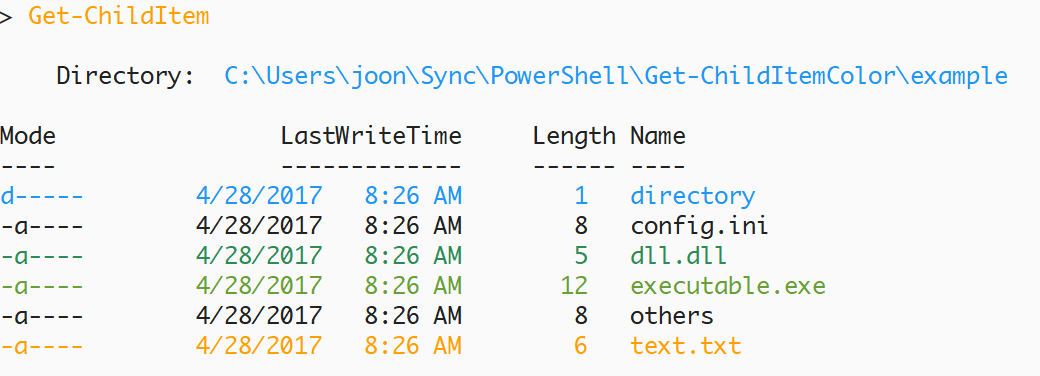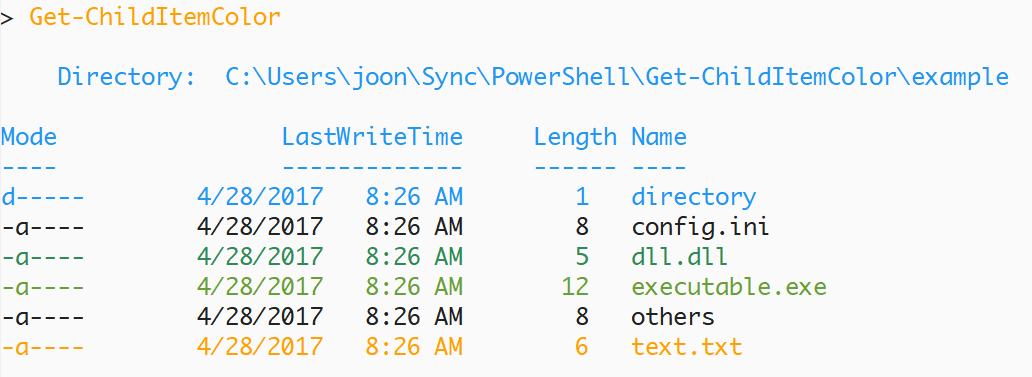Get-ChildItemColor
Get-ChildItemColor provides colorization of outputs of Get-ChildItem
Cmdlet of PowerShell. It is based on Tim Johnson’s script, another script
by the PowerShell Guy, and PSColor.
It provides two main functionalities:
- Directly provide coloring outputs of
Get-ChildItemby modifyingOut-Default. Once the module is imported,Get-ChildItem’s output will be automatically colored. It does support pipeline (e.g., ~Get-ChildItem | grep “.git”~). Also, now the directory name and the headers of its output have consistent colors. This is an adaptation of PSColor. - It provides
Get-ChildItemColorFormatWide, which usesWrite-Hostto output coloring. This is becauseGet-ChildItemColor | Format-Widedoes not allow multiple colors in one line. As a result, pipeline does not work withGet-ChildItemColorFormatWide.
It also provides Get-ChildItemColor, which just changes
$Host.UI.RawUI.ForegroundColor and keep the item object intact. This was the
implementation before v2.0.0, and it does support pipeline. (e.g.,
~Get-ChildItemColor | grep “.git”~). The main shortcoming of this approach is
that the directory name and the headers of its output have inconsistent
colors.
Screenshot:
Get-ChildItem (Colorized)
Get-ChildItemColorFormatWide (ls equivalent)
Get-ChildItemColor
Install
Install from PowerShellGallery
PowerShellGet is required, which is included in Windows 10 and WMF5. If you are using PowerShell V3 or V4, you will need to install PowerShellGet.
Then, you can run Install-Module -AllowClobber Get-ChildItemColor. Note that
you need -AllowClobber option so Get-ChildItemColor may override the
existing command Out-Default.
Install from GitHub
After cloning the repo, you can put files in /src folder into
Get-ChildItemColor folder under your PSModulePath
(e.g., $ENV:UserProfile\Documents\PowerShell\Modules for PowerShell 6 and
later). The master branch always contains the latest release version.
Install from Chocolatey
The module is available as a Chocolatey package. Install it using choco install get-childitemcolor.
Usage
When you import the module:
Import-Module Get-ChildItemColorit provides a proxy function for Output-Default, so Get-ChildItem’s output
will be automatically colored. In addition, it provides two functions,
Get-ChildItemColorFormatWide and Get-ChildItemColor (the latter is
unlikely to be useful, but remained intact just in case).
You can add aliases to these functions for convenience. For example, I have the following in my profile[fn:pathProfile] (please do not put this into ISE profile[fn:pathProfileISE] as it does not work in ISE):
If (-Not (Test-Path Variable:PSise)) { # Only run this in the console and not in the ISE
Import-Module Get-ChildItemColor
Set-Alias l Get-ChildItem -option AllScope
Set-Alias ls Get-ChildItemColorFormatWide -option AllScope
}So l yields colored output of Get-ChildItem and ls yields colored output
of Get-ChildItem | Format-Wide equivalent.
[fn:pathProfile] $Home\[My ]Documents\WindowsPowerShell\Profile.ps1
[fn:pathProfileISE] $Home\[My ]Documents\WindowsPowerShell\Microsoft.PowerShellISE_profile.ps1
Customizing color
One can dynamically change the color scheme for different items, thanks to asidlo’s contribution. See the example below.
# Change color for directories to Blue
$GetChildItemColorTable.File['Directory'] = "Blue"
# Change color for executables to Green
ForEach ($Exe in $GetChildItemColorExtensions.ExecutableList) {
$GetChildItemColorTable.File[$Exe] = "Green"
}Customizing vertical space
You can adjust the vertical spacing using $Global:GetChildItemColorVerticalSpace. Default is 1 (PowerShell’s
default is 2).
$Global:GetChildItemColorVerticalSpace = 1Authors
Changelog
v2.2.0
- Fix #27, Display issue with Chinese. (Thanks to shiena)
v2.1.1
- BUGFIX: Print directory names correctly when
-Recurseoption is used
v2.1.0
- Re-organize folder structure
v2.0.0
- Incorporate PSColor’s implementation of coloring the output of
Get-ChildItem. - Add
$Global:GetChildItemColorVerticalSpaceoption.
v1.3.1
- PR #21: Added ReparsePoint (symlink) detection, matched color scheme with Linux (thanks to cmilanf)
- Make empty lines consistent between Get-ChildItemColor and Get-ChildItemColorFormatWide (Fixes #17)
v1.3.0
v1.2.3
- Add LICENSE
v1.2.2
- Improve README (#15)
- Beautify code
v1.2.1
- PR #13: Fallback to Gray when no
OriginalForegroundColor(thanks to mikesigs) - PR #12: Fix a typo (thanks to jqly)
v1.2.0
- Robust to non-file entries (Issue #10)
v1.1.0
- Revert back to previous implementation of
Get-ChildItemColorFormatWide
v1.0.0
- The script changes
$Host.UI.RawUI.ForegroundColoronly and keep the item object intact Get-ChildItemColorFormatWideis basicallyGet-ChildItemColor | Format-Wide
v0.5.3
- Better performance by reducing if’s
- Proper printing of
DirectoryEntryforFormatWidecase
v0.5.2
- Published on PowerShellGallery
- Refactoring; separate out two functions
v0.4.2
- Make it a PowerShell module
v0.4.1
- Returns vanila
Get-Childitemresults forDictionaryEntrycases.
v0.4.0
- Make function names consistent to the PowerShell naming convention (#8)
- Use parameters more consistently,
-Pathworks with paths with spaces (#3), and-Forceworks (#9)


